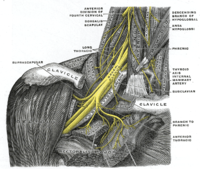
Photo from wikipedia
BACKGROUND: Nerve transfers for elbow flexion in brachial plexus injuries have been used with increasing frequency because of the higher rate of success and acceptable morbidity. This is especially true… Click to show full abstract
BACKGROUND: Nerve transfers for elbow flexion in brachial plexus injuries have been used with increasing frequency because of the higher rate of success and acceptable morbidity. This is especially true in upper and extended upper-type brachial plexus injuries. OBJECTIVE: To present the clinical outcomes of nerve transfers for elbow flexion in patients with upper and extended upper-type brachial plexus injuries. METHODS: A retrospective cohort review was done on all patients with upper and extended upper-type brachial plexus injuries from 2006 to 2017, who underwent nerve transfers for the restoration of elbow flexion. Outcome variables include Filipino version of the disability of the arm, shoulder, and hand (FIL-DASH) score, elbow flexion strength and range of motion, and pain. All statistical significance was set at P < .05. RESULTS: Fifty-six patients with nerve transfers to restore elbow flexion were included. There was a significant improvement in FIL-DASH scores in 28 patients after the nerve transfer procedure. Patients with C56 nerve root injuries and those with more than 2 years' follow-up have a higher percentage of regaining ≥M4 elbow flexion strength. Those with double nerve transfers had a higher percentage of ≥M4 elbow flexion strength, greater range of elbow flexion, and better FIL-DASH scores compared with single nerve transfers, but this did not reach statistical significance. CONCLUSION: Nerve transfer procedures improve FIL-DASH scores in upper and upper-type brachial plexus injuries. After nerve transfer, stronger elbow flexion can be expected in patients with C56 injuries, and those with longer follow-up.
Journal Title: Operative Neurosurgery
Year Published: 2022
Link to full text (if available)
Share on Social Media: Sign Up to like & get
recommendations!